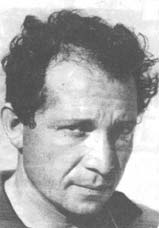 |
The 1968 Games were in Mexico with the yachting events being sailed at Acapulco. The classes remained the same for the third consecutive Olympics: 5.5 Meter formula boat, Dragon, Star, Flying Dutchman and Finn. However, there was movement on the part of the IYRU to develop new classes for the Olympics. Some picked Henning Wind, the Danish Finn sailor who had won the Gold Cup and was second in the Europeans this Olympic year. Others favoured Willy Kuhweide, the 1964 Olympic Gold Medalist, or Jorg Bruder, the Brazilian who had won the Pan American Games last summer. Few felt that Valentin Mankin, the veteran Russian Finn sailor and an excellent heavy weather helmsman, had much of a chance for the Gold Medal in the light weather so typical of Acapulco.
But the wind disobeyed the weathermen, and Mankin surprised everyone with a week of almost flawless tactical racing. Never below seventh at any turning mark, the Russian compiled a record of three firsts, two seconds and a third in the seven races to beat Hubert Raudaschl of Austria by almost 42 points. Fabio Albarelli of Italy won the Bronze Medal, finishing only 1.7 points behind Raudaschl. The winds were basically sea-breezes. Off Acapulco the sea-breeze (mainly S.S.W.) would tend to back in the morning and veer in the afternoon. The Acapulco sea-breeze shifts continuously by anything up to 30 deg. at a time. |
| Gold Medal Winner 1968 Valentin Mankin |
|
One never knew whether a shift was temporary or part of an overall back or veer. The swell was most difficult with tremendous differences in wind strength between crest and trough. The great danger was that the boat would stall on the crests, leaving you wallowing and fighting to get back into the boat in the trough. The currents were wind driven from 1/2 to 11/2 kts, but only the top few feet of water was affected, sliding over the colder, more dense water underneath. The inertia of such a mass of moving water is enormous and once a current was set in motion it would take up to 48 hours for a wind in the opposite direction to reverse the flow. |
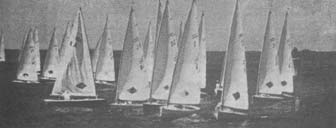 |
| The fleet at the 1968 Olympics |
|
The 1972, the Olympic yachting events were scheduled for the same location as the 1936 Olympics - Kiel, Germany. The IYRU had conducted a design competition for new Olympic classes. The Australian-designed Contender, a singlehander slightly longer than the Finn with stays and a trapeze, won the monotype competition. The theory was that the trapeze would minimise the weight competition which was a factor in heavy weather Finn sailing. However, it turned out that it takes longer to tack a Contender and consequently the competition and tactics in a race tend to be reduced. Since the factors which were being minimised (strength, endurance, agility, etc.) are factors which most Olympic events are designed to test, the IYRU decided that the Finn was still the best Olympic Monotype boat. However, the IYRU did permit the Finn Class to be modernised by having the host country provide aluminium masts instead of wooden ones for the 1972 Olympic Games.
|
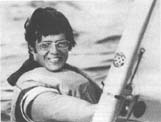
|
For the 1972 Olympics, IYRU decided to drop the 5.5 Meter, which was the last formula boat in the Olympics where design was a factor. Besides the Finn and Flying Dutchman, they retained the 3 man keel boat, the Dragon and the two-man keel boat, the Star. The replacements for them were also approved for the Kiel games, a new type three-man keel boat, the Soling, and a two-man keel boat, the Tempest. This increased the number of Olympic events from five to six. Kieler Fiord is often thought of as synonymous with strong winds and heavy weather sailing, but the wise will tell you "anything can happen at Kiel". But even few of the wise would have been prepared to forecast two weeks of mild weather and light winds for the sailing events of the XX Olympiad. Thus the 35 helmsmen who competed in the Finn Class at the 1972 Games found their long hours in the gym of little use to them and had instead to call on all their resources of skill, light weather tactics, strategy and patience to finish well - or sometimes just to finish.
|
Gold Medal Winner 1972
Serge Maury |
|
Before the Olympics there had been a severe controversy about the masts to be supplied by the organiser. Most of the competitors favoured the old wooden masts, which they were used to, and had qualified with in their national trials. Only a few skippers had gained experience with the new aluminium masts they were forced to use in the Games. The Finn competition in Kiel ended with some big names quite down on the Scoreboard! In surprising light air, Serge Maury of France won the Olympic Gold Medal while Elias Hatzipavlis from Greece got 2nd and Victor Potapov from Russia 3rd. The decisive race was the fifth, when only three boats were able to finish within the time limit. |
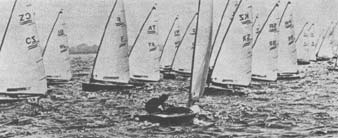 |
| The fleet at the 1972 Olympics |
|
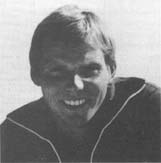 |
Montreal, Canada was scheduled to host the Summer Olympic Games 1976 with Kingston, Ontario on the Great Lakes to be the scene of the yachting events. By a unanimous vote, the Finns were determined to be the best monotype for the 1976 Olympics. At the request of the International Finn Association, the IYRU did modify the regulations concerning the Finn. Canada would furnish the hulls, however if the contestants so desired, they could bring their own sails and masts and did not have to use those furnished by Canada provided the choice was made in advance. This would eliminate the practice at other Olympics where the contestants spent innumerable hours shaping and tuning the rigs furnished by the host.
|
| Gold Medal Winner 1976 Jochen Schumann |
|
Not until the weather mark of the last race was it clear how the medals would be distributed in the Finns. First around was Jochen Schumann from the German Democratic Republic with a tenacious cover on Andrei Balashov of the Soviet Union. Australian John Bertrand, the other contender for the gold was a distant 12th. Although later passed by two boats, Schumann finished comfortably ahead of the Russian and the Australian to assure his win. As striking as Schumann's excellent performance was the poor showing of the pre-race favourites, David Howlett of England and Serge Maury of France. The fact that they had to use hulls provided by the organiser, had upset many of the top helmsmen, who had done superbly well in their own Finns between the Kiel and the Kingston Olympics. Those who usually had the boat speed to pull them out of a hole were now in a position in which they had to rely on their tactical prowess, and they had very little practice at pulling up through the pack with a boat of only average speed.
With the Star and Dragon eliminated, the Tempest and Soling classes were scheduled again. To fill out the schedule, a two-man catamaran, the Tornado was chosen in recognition of the growing popularity of this type of sailing. The Flying Dutchman two man centreboard class was rescheduled but the IYRU was so impressed with the new 470 class, another two-man centreboard class, they scheduled it also, thus keeping six yachting events in the Olympics for 1976. |
For the 1980 Olympics in Moscow, with the yachting events in Tallinn the IYRU decided to bring back the Star into the Olympic programme and to eliminate the Tempest again. The event suffered severely from the boycott which was initiated by the United States. A number of potential winners were excluded from the start. Some of those who came, felt uncomfortable within the narrow limits of the strict organisation and performed poorly. The favourites: Jochen Schumann, Mark Neeleman, Lasse Hjortnas, and Minski Fabris failed to collect the medals. Outsiders like Esko Rechardt (Gold) and Wolfgang Mayrhofer (Silver) took the honours in front of the only successful favourite Andrei Balashov who won Bronze. Another favourite Jose Luis Doreste was disqualified twice for pumping in the first and second race and was totally demoralised. Wind conditions were better than expected based upon the experiences from the Pre-Olympics, varying between 3-5 Beaufort.
|
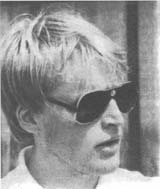 |
| Gold Medal Winner 1980 Esko Rechardt |
|
| 1968 Acapulco, Mexico (36 entries) |
| 1. |
Valentin Mankin |
SR |
11.7 |
| 2. |
Hubert Raudaschl |
OE |
53.4 |
| 3. |
Fabio Albarelli |
I |
55.1 |
| 4. |
Ron Jenyns |
KA |
67.0 |
| 5. |
P. Kouligas |
GR |
71.0 |
| 6. |
J. Winquist |
L |
72.0 |
| 7. |
Arne Akerson |
S |
77.0 |
| 8. |
Philippe Soria |
F |
80.0 |
| 9. |
Jorg Bruder |
BL |
90.0 |
| 10. |
Hyt |
KR |
91.7 |
| 11. |
Jonty Farmer |
KZ |
90.7 |
| 12. |
Andy Zawieja |
PZ |
115.7 |
| 13. |
Jurgen Mier |
DDR |
117.7 |
| 13. |
Carl Van Duyne |
US |
117.7 |
| 15. |
Willy Kuhweide |
G |
120.0 |
| 16. |
A. Bally |
Z |
124.7 |
| 17. |
Obarrio |
A |
125.0 |
| 17. |
Henning Wind |
D |
125.0 |
|
| 1972 Kiel,
Federal Republic of Germany
(35 entries) |
| 1. |
Serge Maury |
F |
58.0 |
| 2. |
Elias Hatzipavlis |
GR |
71.0 |
| 3. |
Victor Potapov |
SR |
74.7 |
| 4. |
John Bertrand |
KA |
76.7 |
| 5. |
Thomas Lundquist |
S |
81.0 |
| 6. |
Kim Weber |
L |
85.7 |
| 7. |
Christian Schroder |
DDR |
91.0 |
| 8. |
Gyorgy Finaczy |
M |
94.0 |
| 9. |
Claudio Biekarck |
BL |
105.7 |
| 10. |
Bret de Thier |
KZ |
109.7 |
| 11. |
Jose Manuel Quina |
P |
109.7 |
| 12. |
Walter Mai |
G |
111.7 |
| 13. |
Mauro Pelaschier |
I |
114.7 |
| 14. |
Jacques Rogge |
 |
117.7 |
| 15. |
Paul Hiles |
KB |
119.0 |
| 16. |
Miroslav Vejvoda |
CZ |
123.0 |
| 17. |
Walter Bachmann |
Z |
132.7 |
| 18. |
Patrick Pym |
K |
133.7 |
|
| 1976 Kingston, Canada (28 entries) |
| 1. |
Jochen Schumann |
DDR |
35.4 |
| 2. |
Andrei Balashov |
SR |
39.7 |
| 3. |
John Bertrand |
KA |
46.4 |
| 4. |
Claudio Biekarck |
BL |
54.7 |
| 5. |
Kent Carlsson |
S |
66.4 |
| 6. |
Anastas Boudouris |
GR |
77.0 |
| 7. |
David Howlett |
Ê |
77.7 |
| 8. |
Sanford Riley |
ÊÑ |
83.0 |
| 9. |
Mauro Pelaschier |
I |
87.7 |
| 10. |
Serge Maury |
F |
88.0 |
| 11. |
Peter Commette |
US |
95.7 |
| 12. |
Jose Luis Doreste |
E |
98.7 |
| 13. |
Minski Fabris |
Y |
103.0 |
| 14. |
Jorgen Lindhardtsen |
D |
106.0 |
| 1980 Tallinn, USSR (21 entries) |
| 1. |
Esko Rechardt |
L |
36.7 |
| 2. |
Wolfgang Mayrhofei |
OE |
46.7 |
| 3. |
Andrei Balashov |
SR |
47.4 |
| 4. |
Claudio Biekarck |
BL |
53.0 |
| 5. |
Jochen Schumann |
DDR |
54.4 |
| 6. |
Kent Carlsson |
S |
71.1 |
| 7. |
Ryszard Skarbinski |
PZ |
71.7 |
| 8. |
Mark Neeleman |
H |
76.0 |
| 9. |
Istvan Rujak |
M |
83.4 |
| 10. |
Elias Hatzipavlis |
GR |
89.0 |
| 11. |
Minski Fabris |
Y |
91.7 |
|
|
|